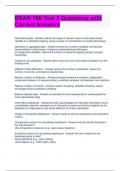Exam (elaborations)
BSAN 160 Test 2 Questions with Correct Answers
- Course
- Institution
BSAN 160 Test 2 Questions with Correct Answers Normalizing data - Answer-reduce the range of values in each numerically valued variable to a standard range by using a variety of normalization or scaling techniques Discretize or aggregate data - Answer-convert the numeric variables into discret...
[Show more]



